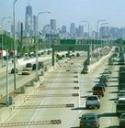Existing Conditions of Pricing and Managed Facilities
Overview of Existing Conditions
The seven-county CMAP region and 16-County Gary-Chicago-Milwaukee (GCM) Corridor face increasing traffic congestion with an estimated cost of $11 billion annually (US Department of Transportation, 2006). This cost includes the direct costs of delay, lost productivity, wasted fuel, environmental impacts, crashes and injuries, higher freight handling costs, and extra time budgeted for travel time variation.
Peak period travel times in the Chicago region often approach 150% (1 1/2 times) of free-flow travel times. In 2005, the Texas Transportation Institute estimated metropolitan Chicago's annual delay per peak hour traveler at 46 hours per year. Calculated over a number of weeks and workdays, this figure translates to 11+ minutes of delay per day for each traveler. The recently devised FHWA Urban Congestion Report also indicates significant congestion in the Chicago region as compared to 19 other regions, as shown in (Table 1).
Table 1

Recent growth in automobile travel compounds this existing problem. Within the Chicago region, daily vehicle miles traveled (VMT) on the limited-access expressway system more than doubled between 1985 and 2005, growing by 136%. During the same period, additional lane miles on the expressway system grew much more slowly at 36%. Recently, expressway VMT has declined, though the legacy of a congested expressway system remains.
Traffic congestion affects not only the traveling public, but also commercial vehicle operations. The Chicago Metropolitan Area contains six of the FHWA's list of twenty-five most delayed interchanges, ranked in terms of goods movement delay. These six interchanges alone inflict an estimated $556,164,000 in costs associated with delay on the movement of goods through and within the region. For a summary of highway interchange bottlenecks in the region, (Table 2). Managed lane facilities are currently used in a number of locations in the region to reduce congestion, including:
Table 2

Dan Ryan Express Lanes

The Dan Ryan Expressway express lanes extend from 26th Street to 67th Street in both directions. Local lanes provide access to all exits starting at 31st Street, while express lanes provide more limited access and egress to high-demand destinations in both directions (US Cellular Field, University of Chicago, Chicago Skyway). The express lanes are limited to passenger vehicles.
Kennedy Reversible Lanes
The Kennedy Expressway features a barrier-separated two-lane express corridor running a distance of 7 miles from Ohio Street (north of the Chicago Loop) northwesterly to the Edens Expressway. Access and egress points are limited to the termini and one midpoint location. The reversible lanes are limited to passenger vehicles.
Figures 2and 3: Kennedy Expressway Reversable Lanes


Several other metropolitan Chicago resources are worth mentioning:
- The Illinois Tollway's I-Pass transponder system separates slow-speed cash transactions from automated high-speed toll transactions using open-road tolling. The system also facilitated a limited congestion pricing system applied to trucks.
- Substantial technological resources, including incident detection and management using traffic management centers.
- The expressway system typically limits trucks to the two right lanes. Trucks are prohibited on Lake Shore Drive. While there may not be a need for additional truck restrictions, compliance is good, indicating an understanding among the public of the benefits of vehicle preferences in managing traffic, even among those not preferred.
|
How well do existing managed lanes facilities work? What, if anything, should be done to improve these facilities? |